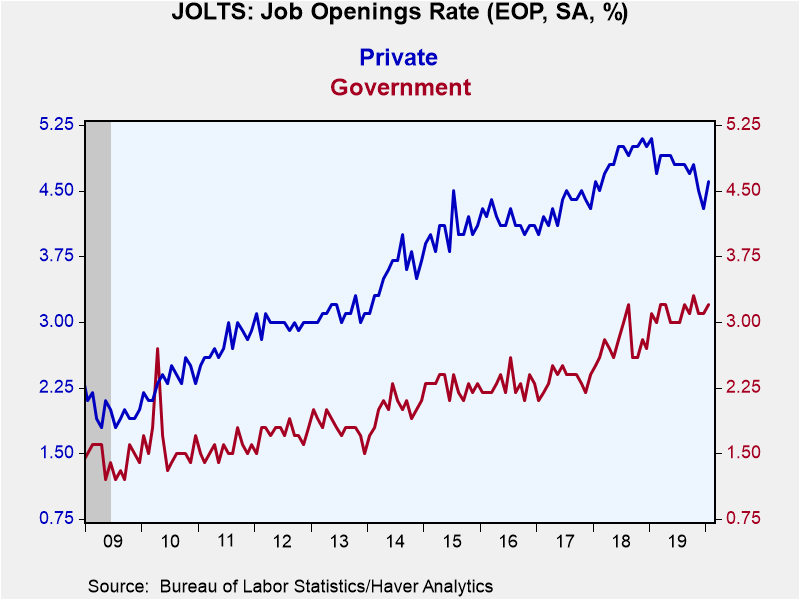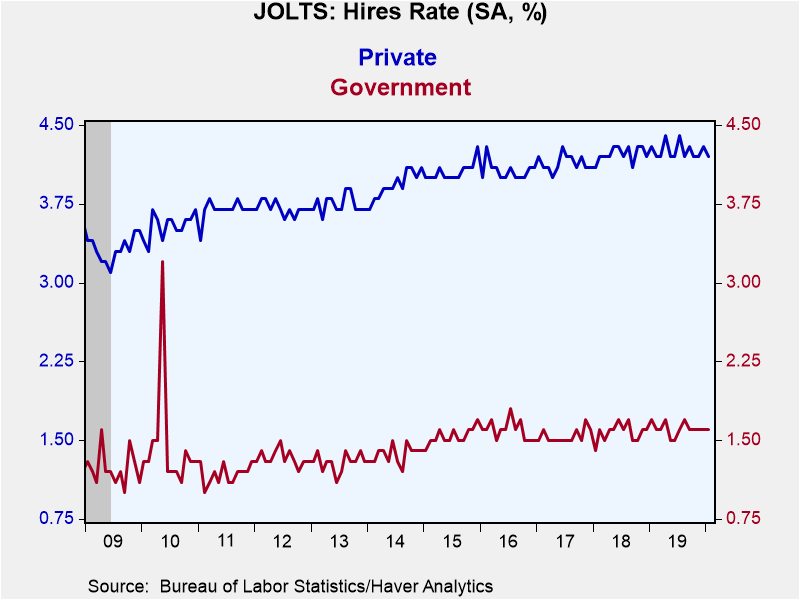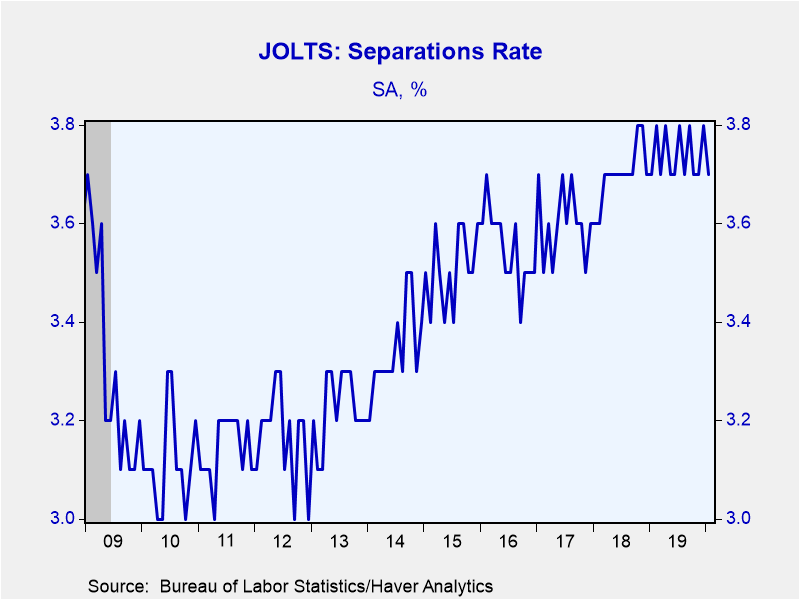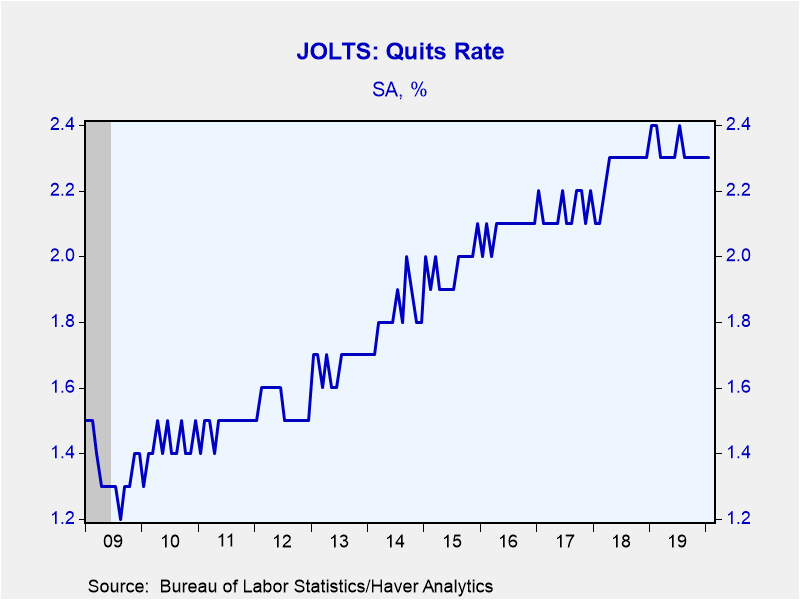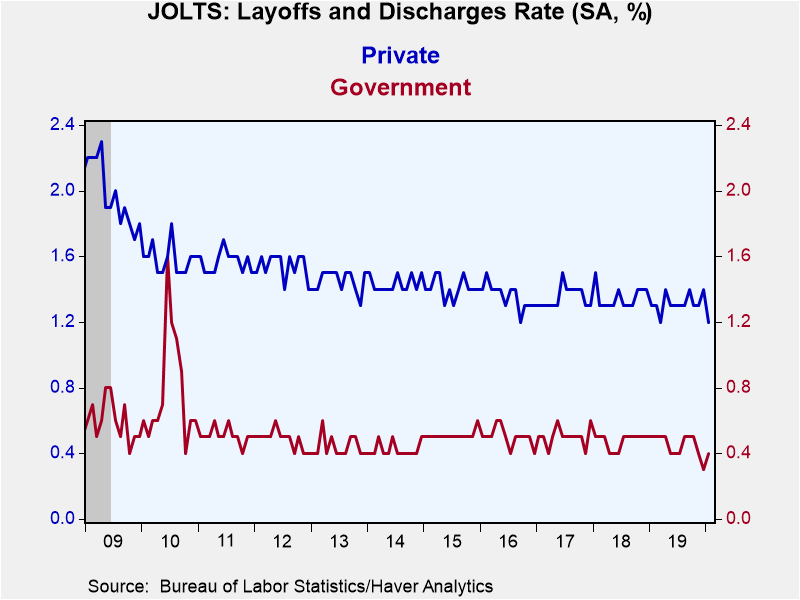 Global| Mar 17 2020
Global| Mar 17 2020U.S. JOLTS: Job Openings Rebound
by:Sandy Batten
|in:Economy in Brief
Summary
The Bureau of Labor Statistics reported that total job openings as a percent of total employment plus openings rose to 4.4% in January after having declined in both December and November, but remained below the 4.8% record of January [...]
The Bureau of Labor Statistics reported that total job openings as a percent of total employment plus openings rose to 4.4% in January after having declined in both December and November, but remained below the 4.8% record of January 2019. The hiring rate slipped to 3.8% in January from 3.9% in December but remains near it expansion high of 4.0% reached last July. The layoff and discharge rate slipped to 1.1% in January, tied for the lowest on record, from 1.2% while the quit rate was unchanged at 2.3%, just 0.1%-pt below the highest of the expansion.
On the last business day of January, the job openings level totaled 6.96 million (+411,000 or 6.3% m/m). This was the largest monthly percent increase in total openings since January 2018. Over the month, the number of job openings increased for total private (+370,000) and edged up for government (+40,000). Job openings increased in finance and insurance (+65,000), federal government (+38,000), and mining and logging (+8,000). The number of job openings rose in each major region with the largest increase in the South region.
Private-sector job openings rebounded sharply in January, rising 6.3% m/m with the rate rising to 4.6% from 4.3% in December. The record rate is 5.1% reached in January 2019. Government sector job openings jumped 5.6% m/m in January with the rate rising to 3.2% from 3.1% in December. The January rate for government was just 0.1%-point off the record of 3.3% in October.
In January, hiring slipped 1.7% m/m to 5.82 million with the hiring rate edging down to 3.8% from 3.9% in December. Private sector hiring fell 2.0% m/m while government hiring increased 3.4% m/m. Hiring was disparate across industries in January hiring weak in goods-producing sectors (led by a 24% m/m drop in mining hires) and generally a little stronger in service-producing sectors (outside of real estate where hires slumped 14.5% m/m). The number of hires decreased in the Midwest and South regions and rose in the Northeast and West regions.
Total separations fell 2.6% m/m in January but this reflects lower involuntary separations. Private-sector separations declined 2.4% m/m while government separations dropped 4.7% m/m. Total separations include both quits (which are generally voluntary initiated by the employee) and layoffs (which are not voluntary and are initiated by the employer). Quits typically serve as an indicator of workers' willingness or ability to leave jobs. Quits edged up 0.1% m/m in January and are up 3% in the past four months. Private-sector quits were up 0.7% m/m in January while government quits fell 9.1% m/m. In contrast, layoffs slumped 11.0% m/m in January and are down 14% over the past four months. Private-sector layoffs plunged 11.8% m/m while government layoffs rose 6.4% m/m.
The Job Openings and Labor Turnover Survey (JOLTS) dates to December 2000; the figures are available in Haver's USECON database.
| JOLTS (Job Openings & Labor Turnover Survey, SA) | Jan | Dec | Nov | Jan'19 | Jan'18 | Jan'17 |
|---|---|---|---|---|---|---|
| Job Openings, Total | ||||||
| Rate (%) | 4.4 | 4.1 | 4.3 | 4.8 | 4.3 | 3.7 |
| Total (000s) | 6,963 | 6,552 | 6,793 | 7,520 | 6,645 | 5,607 |
| Hires, Total | ||||||
| Rate (%) | 3.8 | 3.9 | 3.9 | 3.9 | 3.7 | 3.8 |
| Total (000s) | 5,824 | 5,927 | 5,857 | 5,834 | 5,511 | 5,517 |
| Layoffs & Discharges, Total | ||||||
| Rate (%) | 1.1 | 1.2 | 1.2 | 1.2 | 1.3 | 1.2 |
| Total (000s) | 1,684 | 1,893 | 1,769 | 1,734 | 1,957 | 1,765 |
| Quits, Total | ||||||
| Rate (%) | 2.3 | 2.3 | 2.3 | 2.4 | 2.1 | 2.2 |
| Total (000s) | 3,532 | 3,528 | 3,528 | 3,530 | 3,034 | 3,176 |
Sandy Batten
AuthorMore in Author Profile »Sandy Batten has more than 30 years of experience analyzing industrial economies and financial markets and a wide range of experience across the financial services sector, government, and academia. Before joining Haver Analytics, Sandy was a Vice President and Senior Economist at Citibank; Senior Credit Market Analyst at CDC Investment Management, Managing Director at Bear Stearns, and Executive Director at JPMorgan. In 2008, Sandy was named the most accurate US forecaster by the National Association for Business Economics. He is a member of the New York Forecasters Club, NABE, and the American Economic Association. Prior to his time in the financial services sector, Sandy was a Research Officer at the Federal Reserve Bank of St. Louis, Senior Staff Economist on the President’s Council of Economic Advisors, Deputy Assistant Secretary for Economic Policy at the US Treasury, and Economist at the International Monetary Fund. Sandy has taught economics at St. Louis University, Denison University, and Muskingun College. He has published numerous peer-reviewed articles in a wide range of academic publications. He has a B.A. in economics from the University of Richmond and a M.A. and Ph.D. in economics from The Ohio State University.



